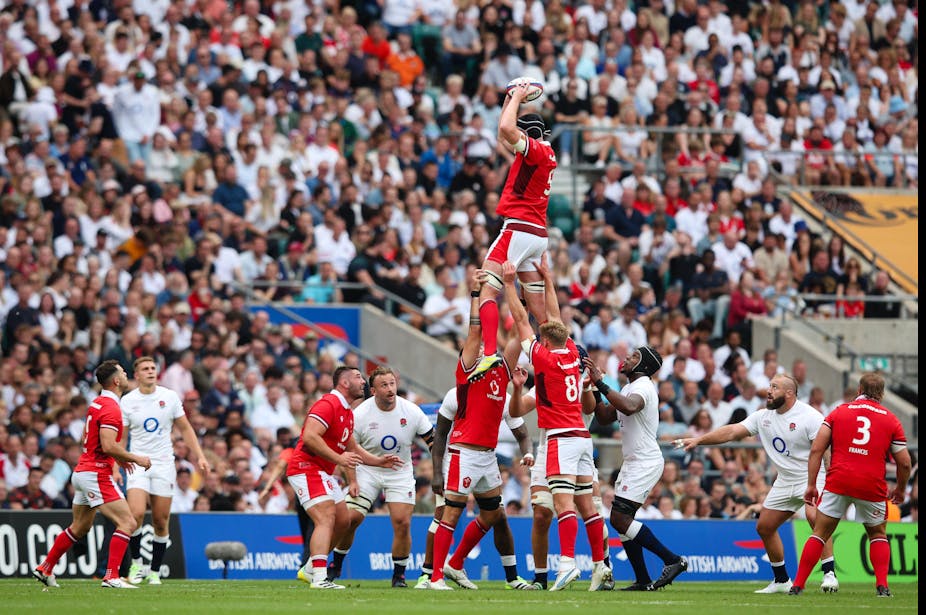With the men’s Rugby World Cup in France almost upon us, the risk of injury during the summer warm-up games has been a serious concern for coaches and players.
While injuries are a feature of any contact sport, our new research shows that the imbalance in size between the quadriceps and hamstrings muscle groups is greater in rugby players than those of active people who don’t play the sport, which increases the risk of injuries, even in training.
Soft tissue injuries, particularly hamstring injuries, have already ruled several players out of the World Cup, raising questions about why such incidents are so common.
The lower leg is the most susceptible part of the body to injuries during a rugby match. And hamstring strains are the most common, contributing to 15% of all injuries in rugby union.
In the previous Rugby World Cup in 2019, hamstring injuries were the second most common match injury after concussion and accounted for nearly 50% of all missed training or playing days. They have been reported as the most common injury during rugby training too.
Anatomy of the hamstring muscles
The hamstrings consist of three muscles running along the back of the thigh, from the hip down to just below the knee. Pushing these muscles beyond their limits through stretching or overloading can lead to painful injuries, with the muscles potentially tearing.
Hamstring strains are particularly prevalent in activities involving running, jumping, sudden stops and starts. The risk of injury increases with age and people with a history of hamstring injuries are at higher risk of experiencing repeat occurrences.
Fatigue and muscle weakness also increase the chances of injury, while inflexible or shorter hamstring muscles struggle to bear the force required for certain movements. Muscles often work in pairs and some experts believe that an imbalance between the quadriceps muscles at the front of the thigh and the hamstring muscles at the back could also contribute to the problem.
To tackle this growing concern, we examined the behaviour and structure of these muscles in rugby union players and compared them with people who were active and exercised, but didn’t play rugby.
What we found
We discovered that the hamstring muscles of rugby players showed greater stiffness compared to the other group. This is not surprising as muscle stiffness is associated with explosive movements such as sprinting, jumping and contact actions, which are all common in rugby training and match play.
Muscle volume is related to the muscles’ ability to exert force. So, as expected, our MRI analysis showed that the quadriceps muscles at the front of the thigh were significantly larger in rugby players relative to body size.
But what was surprising were the findings that there was no discernible difference in the relative size or volume of the hamstring muscles between the two groups. This contradicts previous research which suggested that the relative size of hamstring muscles tends to be larger in strength and power sport athletes, such as rugby, compared to endurance sport athletes and non-athletes.
But our research points to an interesting discrepancy – rugby players displayed an imbalance in size between their quadriceps and hamstring muscles.
Our findings suggest that rugby players could face a higher risk of experiencing hamstring muscle strains, with both increased stiffness of the hamstring muscles and the imbalance between the size of the muscles at the front and back of the thigh playing a role.
Even among amateur rugby players, the process of preparing for and participating in rugby could potentially lead to less flexible hamstring muscles and larger quadriceps muscles relative to the hamstrings. This, in turn, might emphasise the need to focus on developing the size (and therefore, by design, the strength) of the hamstring muscles, which could address the imbalance.
Is there a solution?
A strategy to prevent hamstring injuries should work on reducing the factors that make the risk higher. For instance, it’s important to keep an eye on older athletes and those with previous hamstring injuries, and manage fatigue appropriately.
Encouraging athletes to have a comprehensive warm-up routine is also crucial. When muscles warm, they become more elastic, which might help them handle strain better and potentially prevent tearing.
While we are not entirely sure if stretching before an activity can really lower the injury risk, adding controlled, dynamic stretches to the warm-up might be beneficial, especially if they match the movements used during the sport.
A modern approach involves including exercises in players’ training routines that strengthen. But such exercises should not merely aim to increase muscle size, strength and power. Instead, they should focus on improving flexibility, enhancing the stability of core muscles and strengthening the hamstrings while they are being lengthened.
An example of this is the Nordic hamstring exercise, which involves kneeling on a pad (for knee comfort) and lowering your torso slowly towards the floor with control. This exercise has been suggested to cut the rate of hamstring injuries in half among athletes in team sports.
However, some experts have raised doubts about how effective these exercises really are, and not many teams seem to be adopting these measures. This might be due to the delayed soreness that can come with these exercises.
So, how to reduce hamstring injuries in sports such as rugby remains unclear. And alleviating this problem during the upcoming Rugby World Cup will be difficult – the fatigue from the increased intensity of matches in a concentrated period of time means that managing risk will be problematic.


